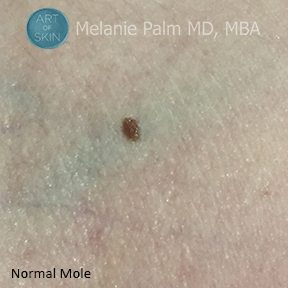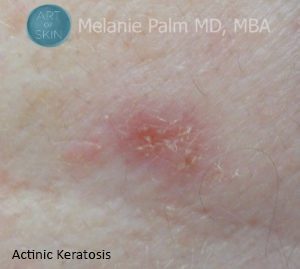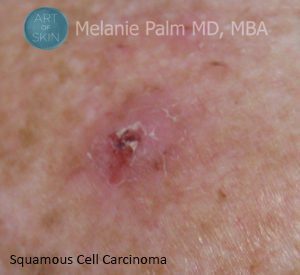May is Skin Cancer Awareness Month and in an effort to help spread awareness, Dr. Palm was asked by Glamour Magazine to share not only her knowledge but also photos of her patients’ skin cancers for an article in their May 2017 issue. As this can often be a confusing and sometimes scary topic, Dr. Palm is passionate about breaking down the information in an effort to educate as many people as possible and encourage patients to be proactive when it comes to their health.
While getting skin checks at least once per year is imperative, there are signs and symptoms that can be cause for concern. Here, Dr. Palm breaks down the differences between what is “normal” and what is cause for a visit to your board-certified dermatologist.
Normal Mole
Normal moles develop through our mid- to late-20s, and any moles that develop beyond this point in time should be evaluated by a board-certified dermatologist.
What a normal mole looks like:
- Small, well-circumscribed
- Brown or skin colored
- Flat or raised
Actinic Keratosis
Actinic Keratosis are commonly referred to as an “AK” and are precancerous lesions, precursors to Squamous Cell Carcinoma, or SCC.
What an AK looks like:
- A rough, red patch
- Typically found in an area of sun exposure
- Often felt before they are seen, as they can be sensitive to touch or are easily irritated
- Sometimes pigmented, they can appear as a brown, scaly patch
- A subtype, Actiinic Cheilitis, appears on the lips most commonly as chronically chapped lower lips
Basal Cell Carcinoma
Basal Cell Carcinoma, or BCC, is the most common form of skin cancer and rarely spreads to other distant organs.
What BCC looks like:
- A pearly, skin-colored bump with small blood vessels traversing the lesion called telangiectasias
- Often appears as an acne-type lesion, but doesn’t heal and will sometimes bleed
- Left untreated, can invade the tissue surrounding it and become ulcerated
- Most often shows up in areas of the skin that have had intense sun exposure (think areas that have been sunburned)
Squamous Cell Carcinoma
Squamous Cell Carcinoma, or SCC, is the second most common form of skin cancer, and is a more aggressive form of skin cancer than BCC. It can spread to other organs, especially in areas such as ears, lips or mucous membranes.
What SCC looks like:
- Appears on sun-damaged skin as a red, rough and scaly raised plaque
- Often bleeds or crusts
Melanoma
Melanoma is a deadly form of skin cancer that will claim approximately 9,700 American lives this year alone. It disproportionately shows up on people who are young and healthy and may spread rapidly from the skin to lymph nodes and other organs, leading to death. It’s imperative to detect Melanoma early for treatment and improved long-term survival.
What Melanoma looks like:
- Early Melanoma most commonly shows itself as a new black “mole”
- With time, grows deeper, developing into a larger, multi-colored plaque or a black bump
- Can display a variety of colors such as shades of brown, blue or white
- Amelanotic Melanoma does not have pigment and can show up as a pink papule
- Think of looking out for the “ugly duckling” among moles, one that doesn’t match the others
- Can be sensitive, bleed or crust
Dysplastic Nevus
The classic ABCD’s accurately describe a Dysplastic Nevus, also known as an atypical mole. They are genetic, and increase the risk of developing Melanoma.
What Dysplastic Nevus look like:
- Asymmetrical mole with an irregular border
- Uneven or several colors
- Large-size moles
- Unusual shape, size, color patterns or just look “funny”
Whether it’s time for your annual skin cancer screening, you’ve never had a screening or maybe you just have questions about specific spots or moles you are unsure about – call us to schedule your appointment with Dr. Palm and rest assured that your skin’s health is being looked after by an expert board certified dermatologist. When it comes to your health, it’s always best to be proactive. We are happy to schedule your appointment, you can reach us at 858-792-SKIN (7546).







